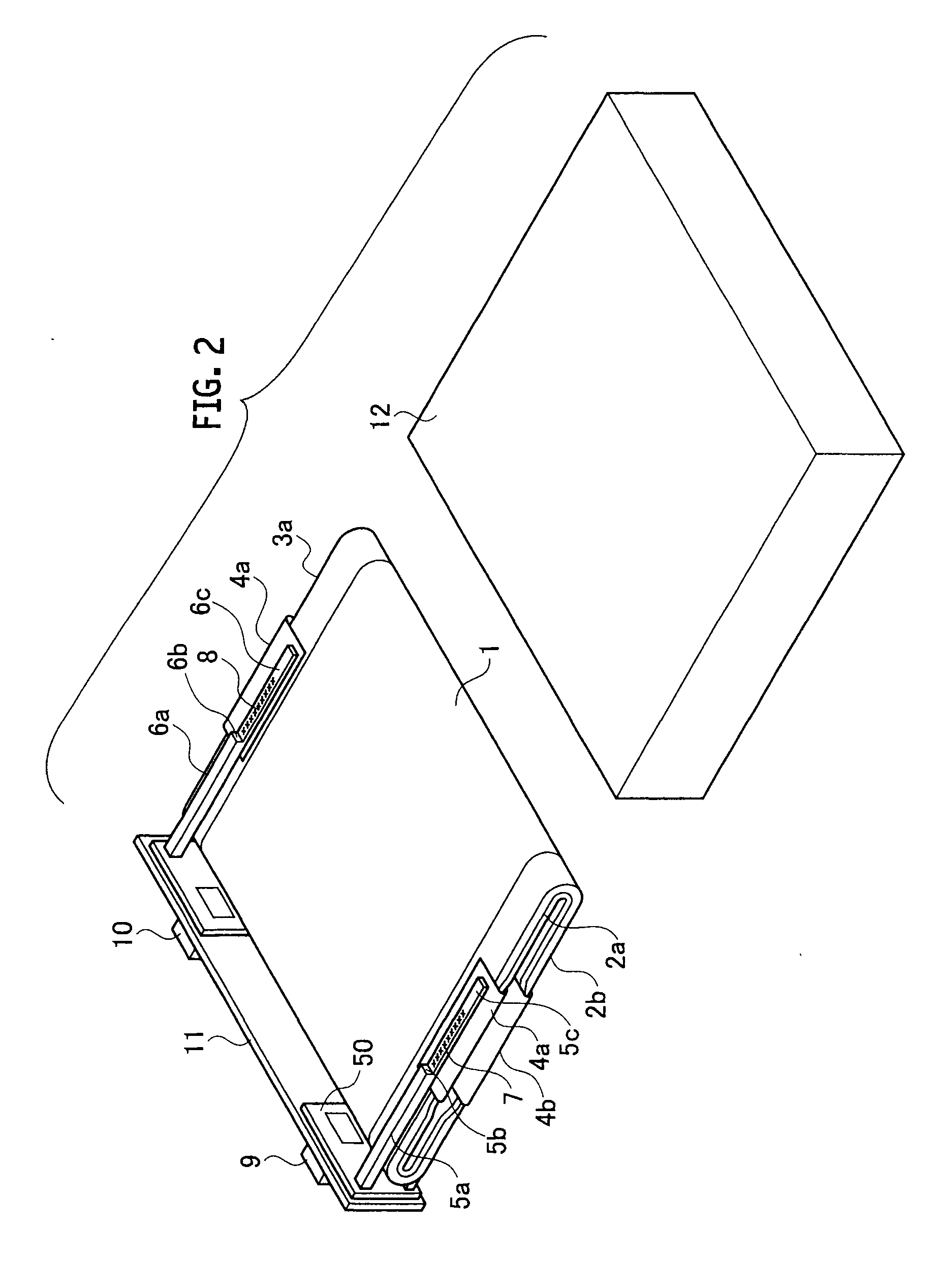Battery and ultrasonic bonding method for battery
- Summary
- Abstract
- Description
- Claims
- Application Information
AI Technical Summary
Benefits of technology
Problems solved by technology
Method used
Image
Examples
first embodiment
[0022]FIG. 2 is a perspective view illustrating a configuration of a battery according to a first embodiment of the present invention. FIG. 3 is a perspective view of the vicinity of a portion where a positive-electrode lead is connected to positive-electrode current collecting tabs, of the battery according to the first embodiment. The battery illustrated in FIG. 2 is a battery using a non-aqueous electrolyte, and includes a container 12, multiple current collecting tabs 2a, 2b (3a, 3b), leads 5a to 5c (6a to 6c), a lid 11, and external terminals 9 (10). The current collecting tabs 2a, 2b (3a, 3b) are each extended from a positive electrode or a negative electrode of an electrode group 1 including the positive electrode and the negative electrode, and are overlapped with each other. The leads 5a to 5c (6a to 6c) are each bonded to at least one of the current collecting tabs 2a, 2b (3a, 3b) by ultrasonic bonding. The lid 11 is configured to close an opening portion of the container ...
second embodiment
[0037]FIG. 6 is a perspective view of the vicinity of a portion where a positive-electrode lead 5a, 5c, and 5d having a cross-sectional area increased gradually is connected to a positive-electrode current collecting tab 2a, 2b, of a battery according to a second embodiment. In the second embodiment illustrated in FIG. 6, the lead includes a thick lead 5a, a thin lead 5c, and a tapered portion 5d having a cross-sectional area gradually increasing from the lead 5c to the lead 5a.
[0038]Even with the battery according to the second embodiment as described above, since the cross-sectional area is increased gradually from the lead 5c to the lead 5a with the tapered portion 5d, the same effects can be achieved as those of the battery according to the first embodiment.
third embodiment
[0039]FIG. 7 is a perspective view of the vicinity of a portion where a positive-electrode lead having a curved surface in a portion with a cross-sectional area changed is connected to a positive-electrode current collecting tab, of a battery according to a third embodiment. In the third embodiment illustrated in FIG. 7, the lead includes a thick lead 5a, a thin lead 5c, and a curved surface portion 5e having a cross-sectional area increasing from the lead 5c to the lead 5a.
[0040]Even with the battery according to the third embodiment as described above, since the cross-sectional area is increased from the lead 5c to the lead 5a with the curved surface portion 5e, the same effects can be achieved as those of the battery according to the first embodiment.
[0041]As described above, the batteries according to the first to third embodiments make it possible to perform the ultrasonic bonding of the current collecting tab and the lead at a portion having a small cross-sectional area, and ...
PUM
| Property | Measurement | Unit |
|---|---|---|
| Area | aaaaa | aaaaa |
Abstract
Description
Claims
Application Information
 Login to View More
Login to View More - R&D
- Intellectual Property
- Life Sciences
- Materials
- Tech Scout
- Unparalleled Data Quality
- Higher Quality Content
- 60% Fewer Hallucinations
Browse by: Latest US Patents, China's latest patents, Technical Efficacy Thesaurus, Application Domain, Technology Topic, Popular Technical Reports.
© 2025 PatSnap. All rights reserved.Legal|Privacy policy|Modern Slavery Act Transparency Statement|Sitemap|About US| Contact US: help@patsnap.com



